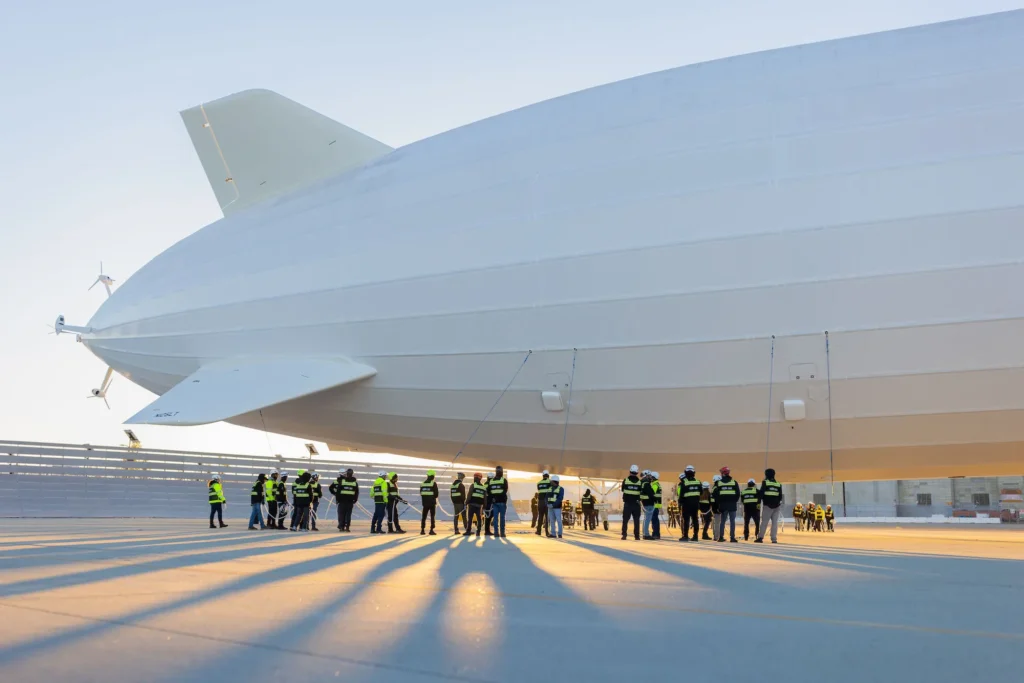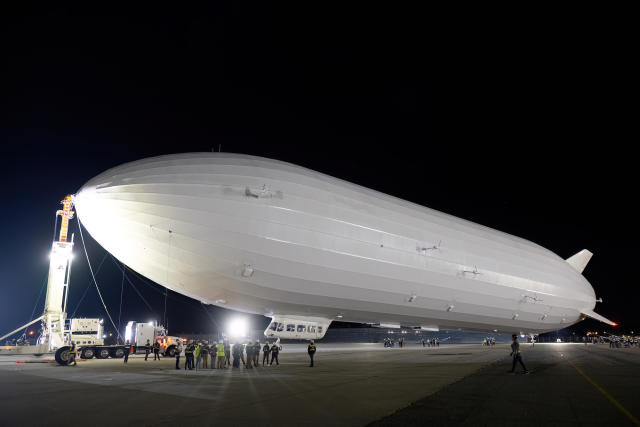As the sun rises over Silicon Valley, the world catches its first glimpse of Pathfinder 1, an ambitious prototype electric airship developed by LTA Research and financially backed by Google co-founder Sergey Brin. This steampunk-inspired giant, visible from the bustling 101 highway, is poised to redefine eco-friendly air travel and bolster humanitarian efforts.
LTA Research, led by CEO Alan Weston, has poured a decade of effort into Pathfinder 1, a colossal airship that dwarfs even the iconic Goodyear blimps. This airship, longer than three Boeing 737s, boasts drone technology, fly-by-wire controls, electric motors, and lidar sensing. It’s not just a spectacle; it’s a potential game-changer, capable of transporting tons of cargo across vast distances.
The airship, Pathfinder 1, will undergo a series of ambitious flight tests in Silicon Valley before making its way to Akron, Ohio, where LTA Research plans to construct an even larger airship, Pathfinder 3. The ultimate goal? To create a fleet of airships for disaster relief and carbon-neutral passenger transportation.
Pathfinder 1, at a staggering 124.5 meters long, is a visual marvel, surpassing the size of current airships and even the massive Stratolaunch plane. Unlike its ill-fated predecessor, the Hindenburg, Pathfinder 1 uses stable helium, not hydrogen, for lift. Its framework, comprising 10,000 carbon-fiber-reinforced tubes and 3,000 titanium hubs, is sheathed in a lightweight synthetic Tedlar skin.
Powered by twelve electric motors running on a combination of diesel generators and batteries, the airship can achieve a top speed of 65 knots. Initial flights, however, will be at more conservative speeds as the team meticulously tests the novel materials and systems.
The testing process began with Pathfinder 1 gently floating from its World War II-era hangar at NASA’s Moffett Field in Mountain View, California, under the cover of darkness. The airship’s response to the morning sun is a key aspect of the initial tests, examining how its helium and weather-resistant polymer skin react to California’s sunshine.
Jillian Hilenski, senior mechanical engineer at LTA, emphasizes the importance of dynamic on-ship flight tests, stating, “We have sophisticated methodology that allows us to replicate real-world conditions using static test stands. However, dynamic on-ship flight tests provide the best data on the health and efficiency of the airship.”

The Federal Aviation Administration (FAA) has granted a special airworthiness certificate for Pathfinder 1, allowing tests in and around Moffett Field and the nearby Palo Alto airport. Initial tests involve flights just a few feet off the ground, tethered to a mobile tripod mast. As testing progresses, the airship will maneuver around Moffett Field before venturing over the San Francisco Bay.
While Pathfinder 1 is set to become a temporary Silicon Valley landmark during the next year, LTA Research envisions a broader impact. CEO Alan Weston expresses excitement about laying the foundation for a new industry, stating, “The innovations and the technologies that we’re about to demonstrate have the potential to lay the foundation for a new industry.”
In a world of electric vertical take-off and landing (eVTOL) air-taxis and hydrogen planes, Weston acknowledges that airships are part of a partial solution. He envisions airships playing a niche role in the transportation architecture, contributing to reducing the carbon footprint of air travel.
The potential applications extend beyond commercial use. Weston believes airships could play a crucial role in responding to natural disasters like earthquakes, volcanic eruptions, and hurricanes. Sergey Brin, who backs the project, also funds a nonprofit called Global Support and Development (GSD) that aims to provide humanitarian aid swiftly after disasters.

While Pathfinder 1 can carry about four tons of cargo, future humanitarian airships are expected to have larger capacities, likely utilizing zero-carbon technologies like hydrogen fuel cells. LTA Research acknowledges the challenges of reintroducing large airships and is working closely with the FAA to ensure safety and certification.
As Weston notes, “The last maiden flight of an airship like this was the Graf Zeppelin II in 1938. The FAA wasn’t even around then.” In the evolving landscape of aviation, Pathfinder 1 represents not just a step forward in technology but a potential leap toward a more sustainable and versatile future. The FAA’s experimental certificate for Pathfinder 1 is valid until September 2024, marking a crucial period for the airship’s continued development and validation.